Poor lighting negatively impacts sales, operating expenses and profitability.
Examples of good retail lighting confront you every day, but its impact lies just beneath the level of conscious thought. What you may notice when you enter a skillfully lit area is that you feel comfortable, go there often and buy products. Barnes & Noble book stores have that warm, golden glow for a reason. Victoria’s Secret is one of the brightest stores in any mall and Finish Line is one of the darkest, also for good reasons. You can see good lighting in every category of retail from auto parts to groceries... but too often, good lighting is not found in furniture stores!
The best way to understand good lighting is to recognize not good lighting. Having a low light level is not good in a furniture store. If your store has only track lighting, your light level is probably not good. If you use incandescent spots and floods in your track lighting, that’s not good. And, if you have a “cool white” fluorescent on your sales floor that’s really not good. The reason these examples are not good is simply this: You are wasting money and missing sales.
Figure 1: LIGHTING LEVELS IN LOCAL HIGH POINT STORES
(Measured in Footcandles)
|
STORE NAME |
AMBIENT LIGHT LEVELS |
PRODUCT HIGHLIGHTS |
| Barnes & Noble | 80 | - |
| Best Buy | 80 | - |
| Basset Furniture Direct | 20 | 30 |
| CVS (former Revco) | 50 | - |
| La-Z-Boy | 20 | 50 |
| Office Depot | 80 | - |
| Rhodes Furniture | <10 | 20 |
This article has lighting in the title, but it is really about sales and operating costs. You can get better lighting in your store while lowering your operating cost. Lighting your sales floor effectively will probably improve your sales by 20%. So let’s discuss the basic facts of light.
Don’t Make Your Showroom Look Like MY LIVING ROOM
Many furniture manufacturers and retailers still believe that they sell furniture for the home, so their stores should have the same lighting as a living room. Yes, furniture buyers do feel comfortable in their living rooms, but they don’t buy furniture there. The reason your showroom shouldn’t look like a living room is that living rooms are not set up to display the features and benefits of furniture to maximum advantage.
To provide you with a frame of reference, for understanding showroom lighting, lets first look at the light level in my living room. Light is measured in footcandles. Set for watching evening TV, the light level there measures 8 to 10 footcandles. Set up for entertaining with all the lights on, my light meter reads 10-15 footcandles. For those of you who haven’t been entertained in my living room, The table on page 28 provides readings taken in High Point area stores.
I picked these stores because they are successful, they probably look just like similar stores in your area and because none of them look like my living room! In addition to lighting rule #1 which is to make your customer comfortable, and #2 give them enough light to evaluate your product, we can add rule #3 which is: don’t try to make your showroom look like my living room.
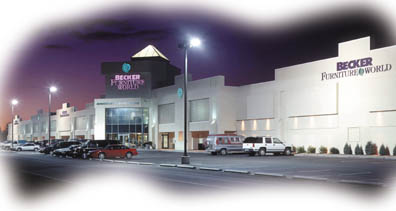 | Becker Furniture World knows how to use exterior lighting to create a landmark destination visible from U.S. Highway 10 in Becker, MN. |
How Much Light Is Enough?
As you can see from the table, light levels vary depending on the type of merchandise offered and the task being performed by the customer. Customers reading package labels at CVS need more light than customers looking for recliners. But even in the furniture group, levels vary significantly. Within an acceptable range, a “good” light level can reflect your personal taste. Light level also depends on how much you want to spend to get that “look” for your store and how much the government is willing to let you use. Five states now limit the watts per square foot allowable for retail lighting.
My personal taste says that 40-50 footcandles of background or ambient light is too much for furniture. It means unnecessary expense and does not allow contrast between what I want you to see and the background. I prefer to keep ambient light at 25 footcandles, about twice the level of my living room. This level is also about twice as high as a store with only track lighting.
One of the facts of light is that “highlights”, the level of light on things you really want customers to look at, should be 3 to 5 times the ambient light level to achieve contrast. Putting 100 footcandles on wood or upholstery is a tricky task and there are few people, most of them photographers, who can get away with it. The rest of us will “wash out” color and make fine wood look like cheap laminate. Highlights of two to three times ambient are easier to manage, especially if the ambient level is at 25 footcandles. We still have the same level of contrast you see in stores (or High Point showrooms) using only track lighting.
The Pendulum Swings
If you have been in the business for a while you know the conventional wisdom on lighting has changed often. Fluorescent lights were largely replaced by incandescent spots and floods. Then incandescent bulbs were out and halogen lights were in. Today fluorescent light is back, but used in combination with halogen.
There are still lots of independent furniture stores using incandescent spots and floods. The problem with incandescent bulbs is that they are inefficient and incredibly expensive to operate (your electricity bill). Some incandescents were so inefficient that they were outlawed for use in the U.S. The surviving bulbs have been changed to get just enough light out of the bulb to meet Federal standards.
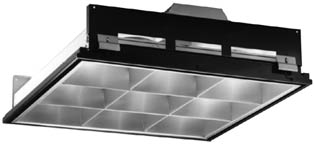 | Fluorescent fixtures are not created equal. Key factors are how much light is generated by the lamp and ballast and how much light makes it out of the fixture. The parabolic lens (shown left) is best for retail. (Courtesy of Indy Lighting, Fishers, IN) |
|
The track system is a high maintenance item. Heads should be 'spotted' each time you change the bulb or move merchandise. Make sure you get heads that hold position when adjusted and make bulb changing easy. (Courtesy of Indy Lighting, Fishers, IN) | 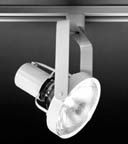 |
How Can Lower Wattage Lighting Appear Brighter?
An important fact of light to remember is that humans, including furniture customers, only see one thing. No, it’s not the price tag. We only see reflected light. We don’t see tables or chairs we see light bouncing off of them. A lot of what we see depends on our perceptions and whether or not the light is focused (See page 34).
Incandescent spots and floods don’t do much to focus light when compared to halogen bulbs. If your store has incandescent track lights, you can use lower wattage halogen bulbs, usually 15 watts lower, and make the store appear brighter. You will probably find that you can remove 10% of the track heads as well and that means real savings.
In addition to saving money on the electricity that goes through the bulb, there are 15 watts of heat per bulb that don’t have to be dealt with by air conditioning. If you don’t believe that adds up, ask a store owner in the south or southwest. The main thing (not that money isn’t important), is that your product looks better and that should mean more sales.
I was careful to say “…and make your store appear brighter,” because what we perceive may have less to do with the amount of light actually present than another fact of light: every light source has a “color temperature.” The most common range we see goes from 2700 (incandescent) to 4100 degrees, the color temperature of ‘cool white” fluorescents. When we replace incandescents with lower wattage halogen bulbs, the halogen light appears to be brighter because the light is focused and the halogen source has a higher color temperature. Halogen light appears to be whiter, which we perceive as brighter.
Back on Track
When the fluorescents came out of stores and incandescents went in, they went in on track. Track really offers a lot of flexibility especially when installed from wall to wall. Track makers like this approach because it uses a lot of track and track heads. As much as 50% of the installed track is wasted unless you line furniture up in rows like cars on a car lot. But if you merchandise in room groups and place those groups at angles for a little visual excitement, the wall to wall lighting system is incredibly inefficient.
Another fact of light is this: You can remove one track head covering about ten square feet and replace it with a fluorescent fixture covering 100 square feet for about the same energy cost and get more light. Therein lies the beauty of combination lighting being used in furniture stores today. Efficient fluorescent fixtures provide higher ambient light levels while halogen track lighting is used only for product highlights. This gives a great “look” to your store and savings in electricity generally pays for a new lighting system in 24 months or less.
I’m not suggesting we go back to 8 foot tubes for that corner grocer look. Corner grocers don’t even use them today. Today’s fluorescent fixtures have parabolic lenses that direct light down and make the fixture less noticeable. You’ll recognize this fixture at Barnes & Noble, Target, Penny’s and most every other mass merchant by 8 inch square openings covering the 2’x2’ or 2’x4’ fixture. The tube used behind the lens will be either a one inch diameter, round tube or a “compact” that appears to be two smaller tubes, side by side. Regardless of the type of tube used it will have good color rendition.
Where to Begin, Begins With Price
Begin with your products, your market, and what you want your store to be. The reason that bright (maybe excessively bright) lighting is appropriate in Victoria’s Secret is that they are selling upscale underwear in the mall. The last thing management wants is that sleazy look of low light levels. Determining how your store should look depends a lot on where your customers shop and the look they expect to see. A fact of light to consider, though a somewhat dated one, is: The higher the price, the lower the light.
If you compete on price alone or run a credit store, then you could probably use only fluorescent lighting, with enough fixtures to supply about 35 footcandles of light. A friend of mine who runs a credit store told me he could turn the lights off and it wouldn’t matter as long as the payment was right. From that price point up, we generally find lower levels of light from fluorescent sources and the addition of halogen track lighting. When you have a good mental picture of what you want based on your marketing position, do a store survey. Store surveys are best when done at night.
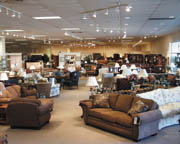 | Marlings Home Furnishings in Topeka, KS (left) combines 2x4 foot fluorescents with parabolic lenses and halogen track lighting. Light on exterior walls adds depth to the already large, 40,000 square foot showroom. |
PERFORM AN ‘AFTER HOURS’ STORE SURVEY
You see your store everyday, but during a survey you should look at it as if for the first time. A good way to prepare to do this is to survey another store first. Go to Barnes & Noble, stand in the parking lot at the furthest point and look at the store. You will notice (1) exterior lighting makes you feel comfortable in the parking lot; (2) the facade of the building has white light which appears brighter than the interior; and, (3) the golden glow from within the store. I personally find the interior to be warm and inviting which is what the designers had in mind.
Enter the store and stop after three steps. What do you see? How do you feel? If you see something that arouses your curiosity and you feel comfortable you are probably going to have a good shopping experience. When entering a furniture store I want to see one or two absolutely killer displays as well as something at a distance that draws attention deeper into the store. During your store survey, look for good lighting at this point.
To get back to the practice survey of Barnes & Noble, stop looking at merchandise and look at the ceiling. You will see fluorescent fixtures with parabolic lenses and tubes with a color temperature of 3000 degrees. The parabolic lenses are champagne gold to make the warm light even warmer. As you look around you will notice contrast provided by other types of fixtures and that the rear of the store is just a little brighter. Go have a cup of coffee, observe the lighting in the store and activity at the cash counter. Good lighting means sales.
Look At Your Store For The First Time
Now that you are “calibrated” by a practice survey, you are ready to look at your store for the first time. Start outside, take the first three steps inside, stop and look. Notice what you see and how you feel as a customer. Do you feel these people know their business and can help you? Does your lighting need to be improved?
I’m not suggesting your store should have the “golden glow” of a Barnes & Noble. In fact, that would be terrible for a furniture business. Warm fluorescents and gold parabolics will distort the color of fabric as will fluorescents in the 4100 degree range of “cool white.” I recommend a neutral temperature of 3500 degrees which blends well with halogen light and balances color between blues and earth tones.
If your survey finds the level and quality of light inappropriate to what you want your store to be, then it is time for a change. If your survey finds only incandescent spots and floods or “cool white” fluorescents in your showroom, you are way overdue for a change. Why does the lighting industry still sell such inefficient, ineffective, low technology products? The margins are great.
Furniture retailers can take advantage of current lighting technology, however, to create a more exciting and productive selling environment. By installing the right fixtures and bulbs in your store, you can reduce energy expense and set the stage for increased sales. Lighting is one of your best salesmen.
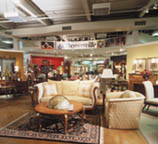 | Efficient Fluorescent Fixtures Provide Higher Ambient Light Levels while halogen track lighting is used only for product highlights. Savings in electricity generally pays for a new lighting systemin 24 months or less. (Courtesy of Thomasville Furniture) |
Focused Light
The easiest way to understand this fact of light is to think of your garden hose with a nozzle. When you open the nozzle just a bit you get a nice, gentle spray that forms a circle. That’s an incandescent flood; 360 degrees of mist. Open the nozzle a little more and it forms a cone, maybe in the 40-50 degree range, still a gentle spray. That’s an incandescent spot. Stand ten feet from your car and see how much water bounces off it. That’s incandescent light hitting your merchandise. Not really effective.
Open the nozzle more and you have a halogen flood. From ten feet the stream of water should be bouncing from your fender. Open more and that narrow stream of water blasting mud off your tire and reflecting back about half way, is a halogen spot. Knowing that we see only reflected light, which do you think is the better light for furniture: A mist (incandescent) or a stream (halogen)?
Fluorescent Light and Color
Fluorescent light got a bad rap from discount stores, groceries and the people who make light bulbs. That last one may surprise you but the industry marketed ‘cool white’ to the point that most consumers standing in front of a rack of bulbs at the big box building products store will see the name, feel comfortable, and buy it. Unfortunately, cool white has the absolute worse color rendition available so consumers and furniture people stopped using fluorescents.
“Color rendition” is a term used to describe how well a light source portrays the true color of a sample. Actually, it’s an average of eight samples. What could be more important to the buying decision than the true color of a sofa?
One thing that comes to mind is the impression formed during the first 30 seconds your customer is in the store. If your lighting is the same as the local discount store or grocery, your customer will probably not feel comfortable purchasing a $2,000 sofa.
Are Halogen Bulbs Expensive?
Incandescent floods or spots sell for $2.00 and halogens sell for $5.00. Obviously incandescents are cheaper to buy, but they cost more to own. The bulb is only 8% of your cost. Labor is 16% and electricity is a whopping 76%. Incandescents generally last 2,000 hours and halogens average 2,500. The halogen’s 25% longer life reduces labor cost. Because of the “garden hose factor” I can replace a 65 watt incandescent with a 45-50 watt halogen and make the merchandise look brighter. Each watt saved in a furniture store is worth $0.25 over a year’s time. I have saved 15 watts or $3.75 on direct energy cost. Excluding labor savings, the halogen really costs $1.25 ($5.00-$3.75) when compared to the $2 incandescent.
Snake Oil and Mirrors
The lighting industry has a few pitches retailers often ask me about. Here are the most common.
These are long life incandescents! There are long life bulbs that have a purpose in life. They really do last longer but, in the typical furniture store, that just means they cost you more to own for a longer time.
Our Fluorescent tubes have a color correlated temperature! Well yahoo! Every light source has a correlated color temperature. This one means nothing.
Our Fluorescent tubes are full spectrum! This can mean something in specific applications. All sources are ‘full spectrum’ but fluorescents have ‘peaks’ at certain points (frequencies) along the spectrum for red, green and blue. These peaks and valleys determine color temperature and color rendition. Color Rendition of 80 or above on a 100 scale and a color temperature of 3500 degrees on the Kelvin scale works for furniture.
By using this 130 volt bulb in your 120 volt circuit it will last twice as long! Kind of true. The bulb will last longer but is less efficient in terms of electricity in and light out. A 90 watt bulb (130V) will perform like a 78 watt bulb in terms of consumption and output. Plus, the light will be a warmer temperature (look yellow) next to 120 volt bulbs.
This bulb is a real value! We see this as consumers all the time. Look at the package! Most bulbs are required by law to show how much light they produce, how much energy they use and how long they last. These “great values” are usually lower price but generally last half as long. Read the label and do the math.
I buy PAR lamps for half that! All halogen spots and floods are “PARs” but not all PARs are halogen. “PAR” in spot and floods has to do with the shape of the bulb and having a PARarabolic reflector. Incandescent PARs don’t perform like incandescent halogen PARs nor do they last as long. There’s really no comparison between the two.
Monte Lee is a Regional Manager for Service Lamp Corporation covering the Southeastern US from his High Point office a distributor of lighting products from all major manufacturers. Service Lamp provides design and support services to corporate sponsored stores, showrooms, Top 100 retailers, and independent furniture stores, nationwide. For more information about the topics in this article, contact Monte care of FURNITURE WORLD at montelee@furninfo.com.